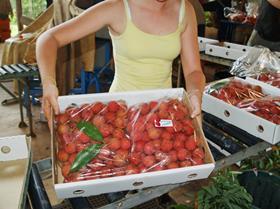
Australia’s lychee crop has taken a hammering this season, the result of a combination of weather conditions during flowering and fruit set that has meant volumes in some production regions are 60-70 per cent lower than 2009/10, which was itself already a low production year.
The poor harvest have so been focused so far on north and central Queensland, although growers are hoping orchards in southern Queensland will prove to have escaped the damage.
“The Tiaro property is due to start just after Christmas, and `we will start` around Australia Day in Pomona,” Kerry Pool of grower Tomarata Group, which has orchards in south Queensland’s Sunshine and Fraser Coasts, told Fruitnet.com. “So far, fruit set on both farms is good and volumes seem to be similar to last year.”
Queensland’s five month season represents the vast majority of the country’s lychee production, but following on from a lacklustre season in 2009/10, the industry is not having an easy time.
“It’s been a battle,” said Alistair Brown of grower-exporter Harrowsmiths International. “The weather’s not being our friend and the currency is not being our friend.”
Heavy rain in September during fruit set is likely the major culprit, and the lower volume has meant that lychee prices are significantly higher than in previous years. Combined with the high dollar, that’s not leaving exporters many options.
Hong Kong and Singapore are the major markets for Australian lychees, and the New Zealand market – which just opened last season – is seen as a significant growth opportunity. But exporters believe most foreign markets will balk at the Australian price this season, if sufficient supplies can even be found to fill orders.
Promotions in New Zealand are unlikely this year, which will mean some of the momentum from last year’s introductory promotions is likely to be lost.
“The dollar will affect all exports,” explained Martin Walker of the United Lychee Marketers Association, which represents the majority of Queensland production and trades under the Sun Lychee brand. “I think the price is going to be a bit high for any volume to be sent into New Zealand.”
Last year’s small crop has also meant there is a lack of promotional levies for industry programmes.



